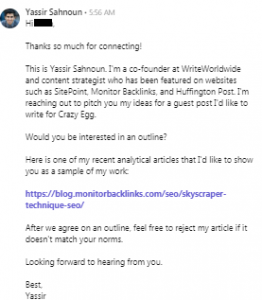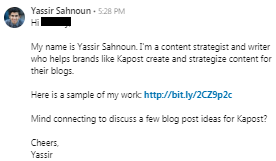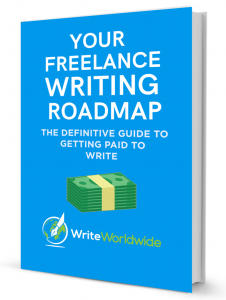When people start thinking about creating a freelance writing business, the first thing that comes to their minds is…
Social proof.
Whether you are hunting for jobs on UpWork, applying for offers on ProBlogger, or cold pitching prospects via email, social proof is the first thing your prospective client might be looking for in your proposal or message.
Luckily for you, getting published on well-established publications is no longer a tough nut to crack.
All that is required of you is decent writing skills (which you are supposed to have) along with some knowledge of certain topics in your niche.
While many recommend not to cold pitch prospects directly via LinkedIn, I had a pretty great success pitching my blog post ideas to some well-known publications.
The following messages got me to close guest post agreements at the publications mentioned in the screenshots:


As you may have observed, the messages differ from one and other, especially the last pitch compared to the first two.
In fact, the third pitch was intended to be a cold pitch for a paid writing gig versus a guest posting request.
Therefore, throughout today’s post, I will break down the elements of the first two messages I have sent to Crazy Egg and Shopify Plus, and drop a few notes regarding why the last one turned into a guest posting deal.
For your information, I have already published two blog posts on Kapost and Crazy Egg. Here are the links:
The Top 7 Popup Forms to Skyrocket Your Conversions – Crazy Egg
Your Ultimate Guide to Managing a Team of Freelance Writers & Editors – Kapost
Both posts were unpaid, but they have contributed tremendously to my portfolio; which, in turn, makes me charge clients more.
Not only that, but they also help me automate lead generation, as I get calls scheduled with prospects via the links in my blog post bios.
Without further ado, let us get into a breakdown of the pitching templates I used along with the step-by-step process I followed to land these guest posting gigs.
Guest Blogging Tips: How I Easily Got Featured at Top Publications like CrazyEgg
Step #1: Make a List of Your Target Publications and Connect with Them on Linkedin
Before you start thinking of pitching publications online, you should first make a list of well-known websites in your niche.
To me, as someone who is specialized in helping SaaS companies with content marketing, my ideal guest posting outlets were websites such as Shopify Plus, Crazy Egg, and Kapost.
At these websites, I could share content that would prove to my clients that I have the necessary expertise to offer my services.
Or, a prospect might be following one of those blogs, which might raise awareness for my personal brand and turn that into a writing gig.
For example, if you are specialized in the e-learning niche, getting published on well-known tutoring websites such as tutor.com would be a great addition to your portfolio.
After you make a list of some publications in your niche, it’s time to hit the ground running! Start connecting on LinkedIn with editors and marketers working at your target companies.
Want to get most of your connection requests accepted? Visit every prospective connection’s profile and drop a note. Something like the following message would do the job:
“Hi [insert first name], We’ve never met, but I just stumbled upon your profile when I was looking for top marketers ( or editors) at [company name]. I am really impressed with your experience in the [niche name]. Can we connect?”
Step #2: Pitch Your Ideas Using Linkedin
Now that you have connected with a good number of prospective publications’ personnel on LinkedIn, it’s time to get your wheels rolling.
Here is my guest posting template for you to copy, tweak, and send:
Hi [First name],
Thanks so much for connecting!
This is [Insert your full name]. I’m a content strategist and writer who works with companies in the [Insert your niche] industry.
I’m reaching out to pitch you my ideas for a guest post I’d like to write for [Publication names].
Would you be interested in an outline?
Here is one of my recent articles that I’d like to show you as a sample of my work: [Link to a personal blog or Medium article]
After we agree on an outline, feel free to reject my article if it doesn’t match your norms.
Looking forward to hearing from you.
Best,
[Insert your first name]
Now you might want me to dive a little bit into a few elements of my pitch template. I have formatted the pitch expressions with bold italics with my detailed explanation underneath in normal text.
Thanks so much for connecting!
The reason why I like using this expression as an opening line is that it refers to an interaction you have already had with that person in a casual, friendly manner. It gives the impression that you are not someone pitching them out of the blue.
This is [Insert your full name]. I’m a content strategist and writer who works with companies in the [Insert your niche] industry.
In this section of the pitch, you will have the opportunity to introduce yourself in a way that would make them see you as the perfect writer for their publication.
Your niche should match or cover theirs. If they are a French learning company, your niche must be anything like French learning, language learning or e-learning.
Here is one of my recent articles that I’d like to show you as a sample of my work: [Link to a personal blog or Medium article]
Since this post is about how to land guest posting gigs, you might have an objection here – especially if you are not yet featured at any website.
For instance, you may as well publish a great post on open blogs such as Medium or on your own personal blog to use as a sample in your pitches.
As long as your writing is great, editors wouldn’t mind to give you the foot in the door to try you out.
After we agree on an outline, feel free to reject my article if it doesn’t match your norms.
One year ago, my colleague and WriteWorldwide co-founder Nick Darlington had an audio interview with top freelance writer Jacob McMillen on how he earned $15,000 in one month.
One of the key topics they discussed was Jacob’s No-Risk Pitch Method he used to land his first $5k writing gig. To me, this method should be an essential part of every pitch since it speaks to your editor’s unannounced objection and puts neediness away.
Not seeing satisfying results from LinkedIn? Enter email.
Many people see LinkedIn as just another Facebook or Twitter. Their minds are wired to good old email.
Therefore, if you do not hear back from an editor within three days or more, you may safely consider re-pitching them via email using the same template. That’s while still making sure to thank your editor for connecting on LinkedIn to make your pitch stand out.
My Ideas Regarding the Third Pitch
Unlike the first two messages, the third pitch lacks personalisation elements. It is short and less personalised. Consequently, it would be harder for you to grab a client’s attention.
My suggestion? Let me give you some homework, and we can turn that into a blog post to publish under your bio here on the WriteWorldwide blog.
I would like you to start an A/B testing campaign using the two different templates in today’s post. I will want you to break down the results you have generated in an outline then email them to yassir@writeworldwide.com.
Now that you have learned the in’s and out’s of getting featured in top publications, what is your excuse?
Still need any help to start establishing your social proof? Comment below with any questions that come up and I will be happy to respond.





Hola!
If you just allow me to mention it,in my own opinion guest post on sites like FastCompany,MoneyCrashers or Blogr can bring a lots of benefits to your name as a writer and boost up your onilne presence.
Bestest Regards: Chris
This is amazing, Yassir!
Congratulations!
Thanks for sharing great stuff.
A question. How do you deal with Editors who accepts your work but remove your bio line upon publishing the article?
Well, if you have agreed to include the bio, then that’s a huge no-no.
Either way, I would just ask them for clarification on it.
Ideally though, you’ll want to know this BEFORE you agree to write the post.
If you’re not getting paid for the work, then the bio is your only benefit, so make sure you get it!
Very valuable post Yassir. I’ll implement the strategies.
Let us know how it works out Irene!
Thanks for sharing this article. I am a marketing service provider and I’m planning to start blogging. That said, this article has provided me with proper tips for blogging.
You’re welcome.